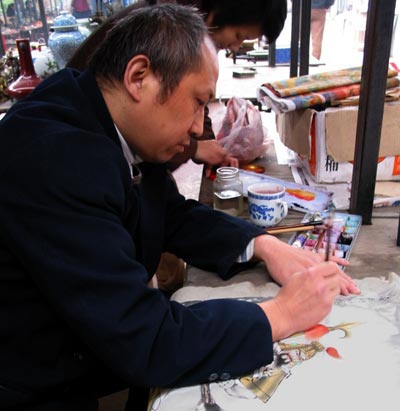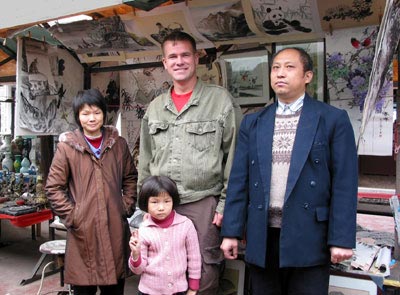
61¼"
27½"

Approximate Measurements
Artwork Panel: 52cm x 98.5cm ≈ 20½" x 38¾"
Silk/Brocade: 61.2cm x 155.5cm ≈ 24" x 61¼"
Width at Wooden Knobs: 70.2cm ≈ 27½"

Close up view of the artwork mounted to this silk brocade wall scroll
There's nothing wrong with this wall scroll. We are just over stocked on this style of bamboo artwork, and this one has been sitting on our shelves for a while.
Reduced to less-than-half the original asking price - way below our cost!
The title is "De Gui Tu", which means "Receive a Highly-Valued Treasure Painting". Catching a fish is a precious gift for the one who fishes. While this is the literal meaning, the painting and title suggest that something good will come into your life as well.
Other characters include the year painted (Winter 2003) and studio where painted (the studio of Li Ying-Lai and Liu Da-Lu, a husband and wife).
This is a elaborate style painting using special black Chinese ink and watercolor on xuan paper (rice paper).
This rice paper was then taken to our mounting shop in Beijing where a hand-made silk wall scroll was created for this painting.
This wall scroll then flew with me from China to the USA and is now located at our San Diego, California gallery, ready to be shipped to you.
Visiting an old friend and artist in Chengdu, I notice a woman is politely waiting for me. Soon enough, I finish my business, and leave my friend to work on some art that I would pick up several days later. The polite woman greets me as I walk out. She quietly asks if I would just take a look at her artwork.
I walk over to her little booth and take a look. The work is good, and I am surprised that she doesn't have a studio-gallery like a lot of artists. She says that she likes to sell in the market, and put paintings in the hands of "the common man". It is then that I realize we have a similar philosophy.

The artist, Li Ying-Lai, was really excited when I told him that I wanted dragons and legendary warriors of China. He said that dragons and warriors are his favorite subject to paint.
I look through her whole collection, and pick out several pieces that I like. Her husband shows up, and helps out getting paintings out of boxes for me to look at.
After we settle and I pay for all of the paintings, he asks if there is any other kind of art that I am looking for. I tell him, in Chinese, "I have been looking for warriors and really cool dragons for a long time". Suddenly he is very excited. Grabbing through several boxes he emerges with a photo album. He hands the album to me and tells me that I must look!
Opening the album, I see a great collection of paintings of "Legendary Warriors of China" and several eye-catching dragons. He tells me that all of the photos are of his paintings.
Now, I get pretty excited, because I've been looking for good warrior-paintings for more than a year and a half, and I am always on the lookout for a good dragon-painting.
He doesn't have any work ready to sell, but we talk about sizes, styles, and which warriors and dragons I want, and even down to what the background of each piece should be. We talk until the end of the day, and finally we talk about the price. I am expecting something high, but the price he gives me is just too low for this quality of work. So, for the first time in my art-buying career, I "reverse-bargain", and tell him that I will pay 50% more as long as the quality is good. He and his wife look puzzled for a second, and then he remarks in Chinese, "I have been waiting to hear someone say that for a long time". The gesture as they took it was not about money, but more about my personal compliment on the quality and importance of the art itself.

Li Ying-Lai with his wife and daughter. As usual, I am the "non-Chinese-looking guy" in the picture.
The artist's name is Li Ying-Lai. He lives with his wife and young daughter near Chengdu, in the Sichuan province of China. As if fitting the stereotype, he loves to paint dragons and warriors, but his wife paints beautiful women, flowers, landscapes, and animals.
They both live the simple life of artists. Both of them have the attitude that the art itself is more important than money. The honor of knowing that their work will now be on the walls of homes throughout the world is the thing they feel strongest about.
Leaving Kashgar (a 2000-year-old trading post and gateway from China to the Middle East), I was sick as a dog, even incorrectly thinking that I had Malaria for a few days. I wanted badly to just head back home to Beijing, but I knew that I needed to head to Chengdu to see this husband and wife artist duo.
It had been over a year since I had seen them, and due to a phone number change, we lost contact for a while. It was time to rekindle our relationship (relationships or "guanxi" is a very important concept in Chinese culture - it's often about showing mutual respect, exchanging favors, developing a friendship before doing business, and building trust).
I found that Li Ying-Lai is doing pretty well now. His artwork was recently featured in "The 3rd Eye" magazine (a major fine art publication distributed in Mainland China and Hong Kong). Other art critics have recommended investment purchases of Li Ying-Lai's artwork, expecting that it will increase in value during the coming years.
This also means it's time to pay more for his artwork. We talked for a while, and decided to increase everything by about 50%. So suddenly a $100 painting from him is now $150, but orders for his artwork pour in from Shanghai collectors that are paying twice as much. The fact that we have "guanxi" from all of my purchases of his artwork before he became famous means that I can still bring his artwork to you at a higher, but still affordable price.
My wife and I ate dinner in the family home. Li Ying-Lai's wife, daughter, and brother-in-law all live in a modest but large apartment just walking distance from their gallery. There home is a fully operational art studio. One room is full of paintings hung to dry, and a large table on which those paintings were created. The living room doubles as an art-mounting studio where the brother-in-law mounts and frames paintings for various Chengdu artists.
Dinner was beef and rabbit with bok choy and a few other vegetables. Their daughter teased me to no end for not recognizing that one of the dishes was rabbit. I'd never been served rabbit before, and even when she said "rabbit" in Chinese I thought she was saying something else. This led to her hoping around the room with her fingers over her head making "bunny ears" and chanting (in Chinese), "Rabbit! Rabbit! Do you know what a rabbit is?"
She was settled down by a stern warning from her father, but she continued to quietly giggle at me for the rest of the evening.
Later, I tried to give her an English lesson, but she asked, "If you don't know what a rabbit is, can you be a teacher?". This led to uncontrollable giggling and derailed the lesson in a way that only a seven-year-old girl can.
I noticed Li Ying-Lai getting antsy as eight o'clock approached. He excused himself and headed for the TV. It turns out there's a certain nighttime soap opera about the Tang Dynasty that he never misses. His wife swatted at him and said, "but we have company". But this did nothing to detour him.
I suddenly realize that they are exactly like my own mother and father in America. Except that my father would be leaving the table for Star Trek or Stargate SG-1, and my mother has long ago given up, and doesn't even give my father the "stink eye" anymore when he pulls something like that.
Basically, they are a normal family. And we are all just people with our strengths and faults. The more you travel around the world, the more you find that while people may look or act different, at our cores, we are all really the same.